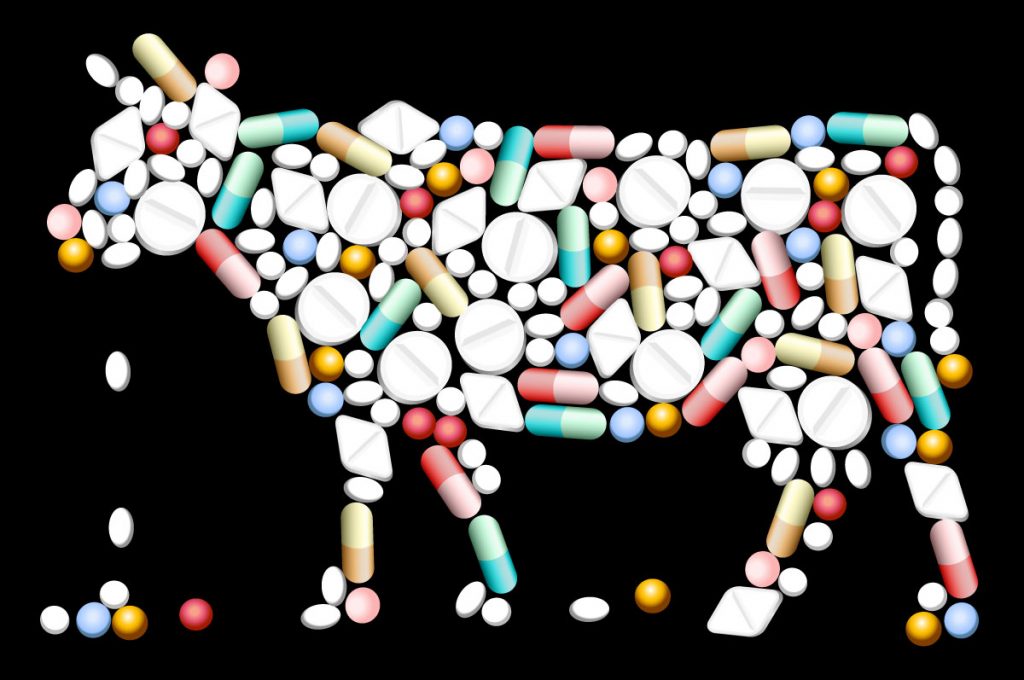During the hearing on South Dakota’s General Permit for Confined Animal Feeding Operations (CAFO), former Dakota Rural Action Chair Don Kelley was prepared to give testimony about the rapidly worsening issue of antibiotics resistance and how CAFO’s contribute to the problem. However, industry representatives objected to Kelley’s testimony and he was not allowed to present at the hearing. Excerpts from his testimony are reprinted here. A recording of Kelley giving the testimony can be found at https://youtu.be/UFWD5zXnX98.
Good morning, Mr. Secretary and Department members. My name is Don Kelley from the Deadwood, SD area, and I’d like to speak to you about an issue of great significance for all of us, which is the rapidly worsening antibiotic resistance of bacteria in our environment. There is good evidence from around the world, including the CDC (Center for Disease Control) here in the States that confined animal feeding operations are contributing to this problem.…
Risk of Antibiotics Resistance
Just how serious is the human health risk from antibiotic-resistant bacteria? From the CDC, we get these typical annual numbers: 2 million antibiotic-resistant infections, 23,000 deaths, 8 million additional hospital days, and between $20 billion and $35 billion in excess direct health-care costs. Here in SD, the state Dept. of Health has published antiobiograms from health facilities around the state, showing that we are experiencing the same problems with antibiotic resistance as are being seen elsewhere.
The problems are serious enough that some infectious disease experts have warned that we are nearing the end of the antibiotic era, when many infections will have become untreatable, and we will have to resort to quarantine and disinfectants alone.… For a variety of reasons, effective new classes of antibiotics are no longer emerging from the pharmaceutical industry.
Although the overuse of antibiotics in human medicine shares the blame for the development of antibiotic resistance, the CDC is clear in assigning part of the blame to industrial food-animal production. In the US, nearly 80% (32.6 million pounds) of the antibiotics sold annually are used in industrial livestock farming. In the US, we use more antibiotics per pound of meat produced than any other nation. The volume of antibiotic use in industrial agriculture increased 20% between 2009 and 2013. More than 60% of these antibiotics in agriculture are considered important for use in humans.…
So, how does a bacterium become resistant to antibiotics? It’s initially by a selection process: all the susceptible bugs are killed, but a few mutants sometimes survive because they’ve developed a means of resisting the drug. With repeated exposure to the drug (especially at low doses), the resistant strain becomes the dominant form. Once this happens, bacteria have tricks by which they can actually transfer drug-resistance genes from one to another, and even from one bacterial species to another.
This process can happen within the body of an animal or human, but can also occur within a manure lagoon. Some of the antibiotic dose makes it through the animal’s system and ends up in manure along with the bacteria, so this selection and gene-transfer process can continue in the pooled manure, increasing the number of resistant organisms.
Legislation
Effective legislation in Congress has been shot down by industrial ag interests every year since 2009. This legislation is the Preservation of Antibiotics for Medical Treatment Act (PAMTA), which has never made it out of committee due to extremely heavy lobbying pressure.
Our primary concern here today is how all this affects our water supplies. There is now very good evidence that antibiotic resistance does get spread in the environment via the water route. Nowadays you can actually measure the concentration of bacterial antibiotic resistance genes in water, and people have done just that in the South Platte River, for example. Here, researchers measured the concentration of these genes upstream and downstream from CAFO’s, and did the same measurements upstream and downstream from municipal sewage-treatment plants along the river. They found a much greater increase in these resistance genes downstream from CAFO’s, as contrasted with the increase associated with municipal waste-water treatment plants.
Considering that humans and livestock share many of the same disease-causing microbes in our digestive tracts, and considering that the volume of waste produced in a large CAFO may be larger than that produced by many cities, a person could wonder why we wouldn’t insist that CAFO manure be dealt with as carefully as municipal sewage, particularly in light of the antibiotic resistance problem.
In conclusion, I think we can see that effective legislation to remove this threat to our water supply and to our future ability to rely on antibiotics has been thwarted so far, in spite of the fact that more than 400 health-related groups have endorsed the PAMTA legislation. In view of increasing public awareness of this issue, we could expect that present CAFO models for food production necessitating antibiotic use won’t be tolerated much longer. Meanwhile, it would be prudent of SD to insist that anyone proposing CAFO development be required to show how they can avoid contributing to this problem.
Sign up for WORC blogs
WORC will send you a notice of new blog posts. You can sign up here.
– Reprinted from Dakota Rural Action’s ACTION REVIEW.

